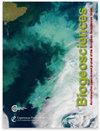过去 2600 年德国中部山区泥炭地和森林生态系统动态的古植物学和生物标记记录比较
IF 3.9
2区 地球科学
Q1 ECOLOGY
引用次数: 0
摘要
摘要泥炭地是全球碳循环中的一个主要陆地碳汇,因此了解泥炭地在不同时期的发展和变化对于预测泥炭地未来的碳预算以及减轻气候变化的不利影响至关重要。为了了解泥炭的发展,许多研究通过分析各种代用指标,包括花粉、大型化石、元素和生物标记分析,对泥炭的古生态动态进行了调查。然而,众所周知,这些代用指标各有其优点和局限性,因此将这些代用指标同时进行研究,可以更深入地了解泥炭地的古生态动态,并系统地比较这些代用指标的威力。因此,在这项研究中,我们分析了德国一处泥炭地(图林根州比尔贝格)的泥炭岩芯,目的是:(a)描述全新世晚期泥炭地发展过程中的植被动态;(b)评估纳入多种代用指标(特别是花粉、植物大化石和生物标志物)在多大程度上有助于加深对这些动态和因素间相互作用的理解。我们发现,尽管该地区的森林构成发生了重大变化,从以山毛榉为主转变为以云杉为主,而且该地区还出现了许多人类影响的指标,但比尔贝格地区的当地植物种群在泥炭地开发的最初阶段直到最近几个世纪一直保持稳定。因此,仅从古植物学数据中几乎无法得出任何变化。将花粉和大型化石分析与元素和生物标记分析相结合,可以进一步了解遗址的发展情况,因为这些代用指标增加了宝贵的额外信息,包括小冰河时期等气候变迁的发生情况,以及排水等近期干扰。本文章由计算机程序翻译,如有差异,请以英文原文为准。
Comparison of paleobotanical and biomarker records of mountain peatland and forest ecosystem dynamics over the last 2600 years in central Germany
Abstract. As peatlands are a major terrestrial sink in the global carbon cycle, gaining an understanding of their development and changes throughout time is essential in order to predict their future carbon budget and potentially mitigate the adverse outcomes of climate change. With this aim to understand peat development, many studies have investigated the paleoecological dynamics by analyzing various proxies, including pollen, macrofossil, elemental, and biomarker analyses. However, as each of these proxies is known to have its own benefits and limitations, examining them in parallel allows for a deeper understanding of these paleoecological dynamics at the peatland and a systematic comparison of the power of these individual proxies. In this study, we therefore analyzed peat cores from a peatland in Germany (Beerberg, Thuringia) to (a) characterize the vegetation dynamics over the course of the peatland development during the late Holocene and (b) evaluate to what extent the inclusion of multiple proxies, specifically pollen, plant macrofossils, and biomarkers, contributes to a deeper understanding of those dynamics and interaction among factors. We found that, despite a major shift in the regional forest composition from primarily beech to spruce as well as many indicators of human impact in the region, the local plant population in the Beerberg area remained stable over time following the initial phase of peatland development up until the last couple of centuries. Therefore, little variation could be derived from the paleobotanical data alone. The combination of pollen and macrofossil analyses with the elemental and biomarker analyses enabled further understanding of the site development as these proxies added valuable additional information, including the occurrence of climatic variations, such as the Little Ice Age, and more recent disturbances, such as drainage.
求助全文
通过发布文献求助,成功后即可免费获取论文全文。
去求助
来源期刊

Biogeosciences
环境科学-地球科学综合
CiteScore
8.60
自引率
8.20%
发文量
258
审稿时长
4.2 months
期刊介绍:
Biogeosciences (BG) is an international scientific journal dedicated to the publication and discussion of research articles, short communications and review papers on all aspects of the interactions between the biological, chemical and physical processes in terrestrial or extraterrestrial life with the geosphere, hydrosphere and atmosphere. The objective of the journal is to cut across the boundaries of established sciences and achieve an interdisciplinary view of these interactions. Experimental, conceptual and modelling approaches are welcome.
 求助内容:
求助内容: 应助结果提醒方式:
应助结果提醒方式:


